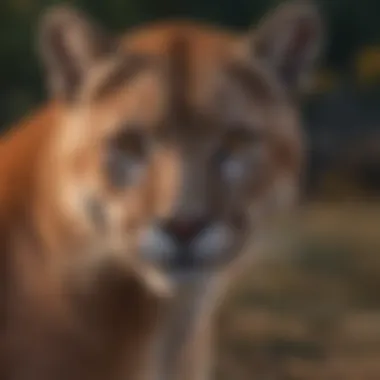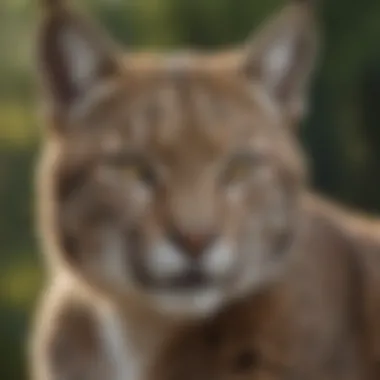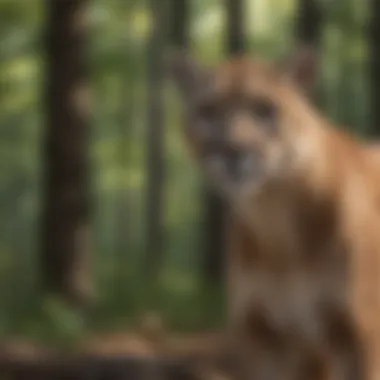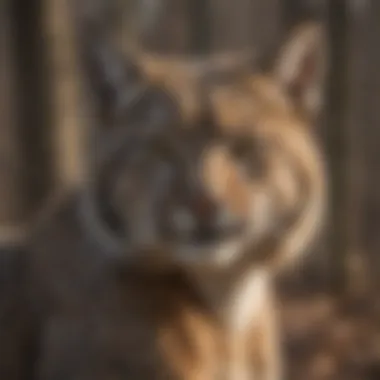Exploring the Enigmatic World of Wild Cats in Missouri


Animal Species Profile
Wild cats in Missouri are a captivating subject of intrigue for those fascinated by the region's diverse wildlife. Among the notable wild felines residing in Missouri, bobcats and cougars stand out for their elusive nature and majestic presence. These creatures offer a unique glimpse into the state's natural heritage.
Physical Characteristics and Appearance
Bobcats, known for their reddish-brown fur with black spots, have distinctive tufted ears and short tails. Cougars, on the other hand, boast a sleek, tawny coat and a powerful build, making them an imposing sight in the Missouri wilderness.
Natural Habitat and Distribution
Bobcats are adept at navigating various terrains, from forests to swamps, while cougars prefer rugged mountainous regions. Missouri provides a suitable habitat for both species, with the Ozarks and Mark Twain National Forest offering key territories.
Behavior and Social Interactions


Bobcats are primarily solitary hunters, preying on small mammals and birds. Cougars exhibit a similar solitary nature, with males maintaining large home ranges to avoid territorial conflicts. Understanding these behavioral patterns is crucial for appreciating the roles these wild cats play in Missouri's ecosystem.
Introduction
The topic of wild cats in Missouri is a subject ripe with intrigue and fascination, drawing the attention of wildlife enthusiasts and nature lovers alike. Missouri's diverse landscape provides a unique habitat for a variety of wild cat species, each with its own distinct characteristics and behaviors that contribute to the rich tapestry of the state's wildlife ecosystem. Understanding the presence and behavior of these elusive felines not only offers a glimpse into the wonders of nature but also sheds light on the conservation efforts necessary to protect and preserve their populations.
Wild cats, including bobcats and mountain lions, play a crucial role in the delicate balance of Missouri's ecosystem. Through examining their habitat preferences, hunting strategies, and interactions with humans, we can gain valuable insights into the complexities of coexisting with these majestic creatures. This article aims to delve deep into the enigmatic realm of wild cats in Missouri, unraveling their mysteries and highlighting the significance of conservation efforts to ensure the continued existence of these fascinating species in the wild.
Overview of Wild Cats
Wild cats in Missouri offer a fascinating glimpse into the state's diverse wildlife. The presence and behavior of bobcats and mountain lions contribute significantly to the ecosystem. Studying these wild cats provides valuable insights into their habitats, behaviors, and conservation status. Understanding the dynamics of these elusive felines is crucial for wildlife enthusiasts, educators, and conservationists. ## cats in Missouri ## - bitat and Range**: Bobcats in Missouri primarily inhabit dense forests, swamps, and brushland. Their adaptability to various habitats makes them resilient predators. Exploring their preferred habitats sheds light on their hunting behaviors and interactions with the environment. The diversity in their range reflects their ability to thrive in different ecosystems. - Diet and Hunting Behavior: Known for their solitary and elusive nature, bobcats are skilled hunters preying on small mammals like rabbits and squirrels. Understanding their hunting strategies and diet preferences is essential for wildlife management and conservation efforts. Their hunting behavior showcases their role in maintaining ecological balance within their habitat. - Reproduction and Family Life: Bobcats reproduce once a year, with females giving birth to litters of kittens in secluded dens. Examining their reproductive patterns provides insights into population dynamics and genetic diversity. The family dynamics of bobcats contribute to understanding social structures and the transmission of behavioral traits. ## Mount Lions in Missouri ## - Hist al Presence: Historically, mountain lions were native to Missouri before facing population declines due to hunting and habitat loss. Exploring their historical presence highlights the changes in their distribution and abundance over time. Understanding their past interactions with the environment can inform present conservation strategies. - Conservation Efforts: Conservation efforts aim to protect and restore mountain lion populations in Missouri. Initiatives focus on habitat preservation, monitoring populations, and reducing human-wildlife conflicts. Analyzing these conservation strategies provides insights into the challenges and opportunities for ensuring the survival of mountain lions. - Interactions with Humans: Mountain lions occasionally encounter humans, leading to conflicts that pose challenges for conservationists and wildlife managers. Studying these interactions helps develop strategies to mitigate conflicts and promote coexistence. Understanding human impacts on mountain lions is crucial for devising sustainable conservation measures.
Behavior and Ecology


Wild cats' behavior and ecology play a significant role in understanding the delicate balance of Missouri's ecosystem. By delving into the nuances of how these magnificent felines interact with their environment, we gain insight into their adaptability and survival strategies. Examining their behavior provides crucial information on hunting patterns, social dynamics, and territorial instincts, contributing to a deeper appreciation of their role in the local wildlife community. Ecology-wise, studying wild cats sheds light on their ecological impact, such as their interactions with prey species, vegetation, and other wildlife in the area. Understanding these aspects not only enriches our knowledge of these elusive creatures but also aids in conservation efforts aimed at maintaining biodiversity.
Territorial Behavior
Territorial behavior is a key aspect of wild cat survival and species sustainability in Missouri. Marking and communication serve as fundamental components of this behavior, allowing cats to establish and defend territories effectively. Marking, often through scent or visual cues, is essential for demarcating boundaries and conveying reproductive status. Communication plays a critical role in signaling dominance, avoiding conflicts, and facilitating breeding interactions. These mechanisms are vital for maintaining social order within wild cat populations, ensuring efficient resource utilization and reproductive success. While marking and communication enhance territorial behavior, hunting strategies further exemplify the adaptability and prowess of wild cats.
Marking and Communication
Marking and communication enable wild cats to navigate the intricate social dynamics and territorial disputes inherent in their ecosystem. Through scent marking, cats leave olfactory cues that communicate information about territory ownership, reproductive availability, and individual identity. Visual marking, such as scratch marks on trees or rocks, serves as a visible deterrent to potential intruders and reinforces territorial boundaries. The unique feature of marking lies in its dual purpose of communication and resource partitioning, allowing cats to coexist and reproduce efficiently within their habitat. However, while effective in signaling ownership and deterring rivals, marking can also attract unwanted attention from competitors or predators, posing potential risks to individuals or offspring.
Hunting Strategies
Hunting strategies embody the essence of wild cats' predatory nature and evolutionary adaptations. From solitary stalk-and-ambush tactics to group coordination in pursuit and capture, cats exhibit a diverse range of hunting behaviors tailored to their prey and environment. Their keen senses, agile movements, and strategic thinking contribute to successful hunts, ensuring sustenance and survival. The key characteristic of hunting strategies lies in their flexibility and efficiency in securing prey while minimizing energy expenditure. Cats' unique feature in hunting involves a combination of stealth, speed, and precision, making them formidable predators across varied landscapes. Despite their advantages in securing food sources, hunting strategies also pose challenges in the face of habitat loss, human encroachment, and competition with other predators, underscoring the fragile balance between predator and prey dynamics in Missouri's wilderness.


Conservation Challenges
Conservation challenges play a pivotal role in understanding and preserving the delicate balance of Missouri's wild cat population. The intricate interplay between human activities and natural habitats poses significant threats to these majestic felines. By addressing conservation challenges, we not only protect the wild cats but also safeguard the biodiversity of the region. Understanding the impacts of habitat loss and human-wildlife conflicts is crucial for formulating effective conservation strategies. Conservation efforts aim to mitigate anthropogenic threats and ensure the long-term survival of Missouri's wild cats.
Habitat Loss
Habitat loss stands out as a primary concern impacting Missouri's wild cat species. Urbanization, deforestation, and agricultural expansion encroach upon the cats' natural habitats, leading to fragmentation and degradation. As their living spaces diminish, wild cats face heightened competition for resources, increased vulnerability to predators, and disrupted breeding patterns. The conservation of existing habitats and the restoration of degraded areas are essential for mitigating the adverse effects of habitat loss on wild cat populations.
Human-Wildlife Conflict
Human-wildlife conflict arises from the overlapping interactions between humans and wild cats in shared landscapes. Encounters between these two groups often result in negative outcomes, such as livestock predation, property damage, and perceived threats to human safety. Effective management of human-wildlife conflict requires a balanced approach that considers the needs of both humans and wild cats. Implementing preventative measures, such as secure enclosures and habitat zoning, can help minimize conflicts and promote coexistence between these species.
Research and Monitoring
Conclusion
In delving into the enticing realm of wild cats in Missouri, the significance of understanding and conserving these majestic felines becomes abundantly clear. From the elusive bobcats to the regal mountain lions, these creatures play a vital role in maintaining the delicate balance of Missouri's ecosystem. By unraveling the intricate details of their behavior, habitat needs, and conservation challenges, we gain a profound appreciation for the wilderness that these wild cats call home.
Preserving the populations of bobcats and mountain lions not only sustains the biodiversity of Missouri but also safeguards the ecological processes that rely on these magnificent predators. The presence of these wild cats indicates a healthy environment, as they regulate prey populations and contribute to the overall health of the ecosystem. As such, efforts to monitor and protect these species are crucial for ensuring the long-term sustainability of Missouri's natural landscapes.
Moreover, studying these wild cats provides valuable insights into predator-prey interactions, evolutionary adaptations, and broader conservation strategies. By examining their territorial behavior, hunting techniques, and reproductive habits, researchers can gain a deeper understanding of the complex dynamics at play in the wild. This knowledge not only enriches our scientific understanding but also informs conservation initiatives aimed at mitigating human-wildlife conflicts and habitat degradation.







